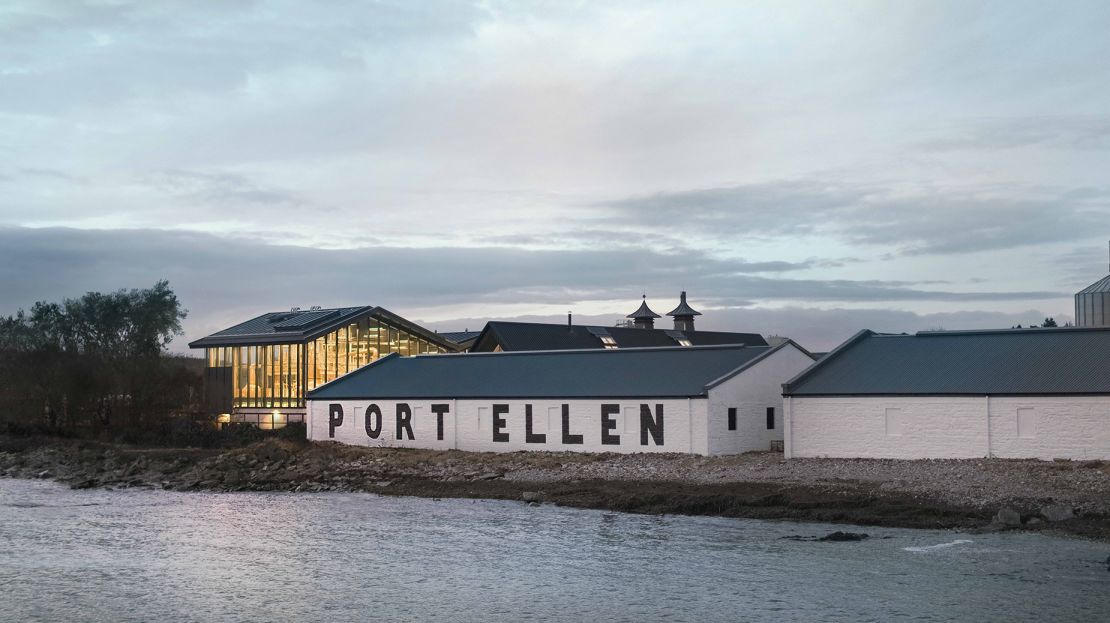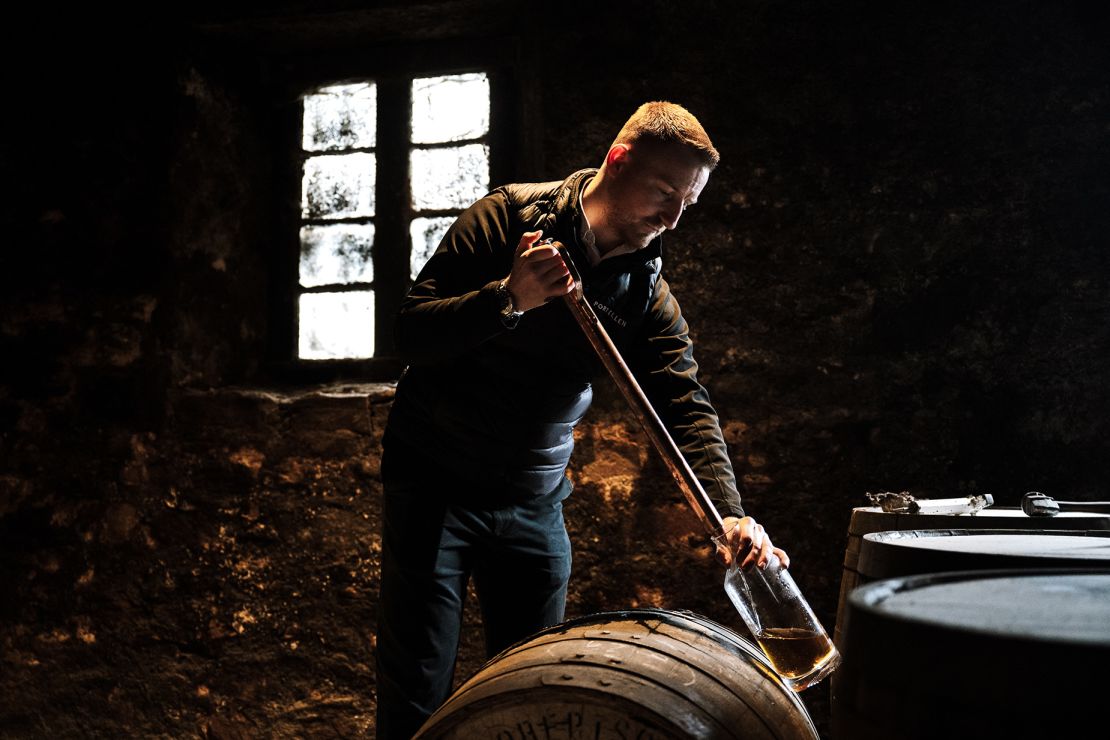Everything you need to know about whisky and its umbilical bond to Scottish identity can be found in Carol Ann Duffy’s poem “Drams.”
“Barley, water, peat,
weather, landscape, history;
Malted. Swallowed neat.”
The words of the UK’s former poet laureate come to mind in the Scandi-vibed lounge of the reborn Port Ellen distillery on the Isle of Islay, where the first drink some visitors are offered is a cup of pine-smoked Lapsang tea from China’s Wuyi Mountains.
It is not what you’d expect to be drinking on a Hebridean island, especially not in a black metal and glass temple to the art of distilling. But it soon makes sense: it’s all about tuning the tastebuds in preparation for sampling some seriously expensive, smooth and aromatically complex single malt.
The luxury visitor experience here is billed as a deep dive into the smokier end of the whisky spectrum, a sensory revelation of the kind evoked in Duffy’s “Drams.”
“The gifts to noses –
bog myrtle, aniseed, hay,
attar of roses.”
And:
“The perfume of place,
seaweed scent on peaty air,
heather dabbed with rain.”
‘Whisky loch’

Port Ellen, owned by international drinks giant Diageo, was closed in 1983 as a global recession and overproduction combined to produce a surplus of unwanted Scotch dubbed the “whisky loch (lake).”
Now it is the newest member of a club of once-shuttered “ghost” distilleries to be lavishly refurbished on the back of a decades-long boom in demand for single malt that, perhaps ominously, has recently shown signs of faltering.
In the four decades between closure and reopening, Port Ellen attracted a cult following amongst self-avowed whisky geeks who detected all sorts of exciting and varied things happening to the spirit as a result of it having been aged in mostly older, well-used “refill” casks at an unusually high strength.
“It was thanks to independent bottlers and some influential enthusiasts that a following gradually built up for these whiskies that, more often than not, were just sublime,” says Roy Duff, editor of Dramface.com, an independent whisky review website and podcast.
“It was pure serendipity. The magic happened because the whisky was forgotten about and left alone. Being in the (less active) refill casks meant the spirit could shine, and the longer it aged in the Scottish climate, the better it got.”
With its long pedigree — the distillery was founded in 1825 — and its seafront location on Islay, a place of pilgrimage for maltheads the world over, Port Ellen is a celebrated member of whisky’s ghost club.
Others that have recently come back from the dead include the Highland distillery of Brora, also part of the Diageo stable, and Rosebank, near Falkirk in Scotland’s central belt.
Another Islay whisky legend, Ardbeg, was mothballed for most of the 1980s but has been spectacularly revived since it it was bought by the mainland distillery Glenmorangie in 1997. In 2022, a single cask of 1975 Ardbeg was sold to a Hong Kong buyer for a reported £16 million ($20 million), more than twice what Glenmorangie paid for the distillery and its stocks.
Such are the rewards on offer for waking a ghost. But reaping them requires deep pockets. First announced in 2017, Port Ellen’s rebirth was delayed by over three years by a combination of Covid-19, post-Brexit problems with the cost and supply of building materials and a shortage of ferry capacity.
Those headaches seem forgotten for now.
The old and new buildings, the latter bedecked with whisky-themed contemporary art, are back in action as Islay’s 10th working distillery. By 2030, there could be 14 — a remarkable concentration for an island only 25 miles (40 kilometers) long and eight miles (13 kilometers) across, with just over 3,000 full-time residents.
Duffy’s seaweed scent and peaty air are in plentiful supply on the balcony off the first floor visitors lounge, which floats above Distillery Road between the kelp-strewn shoreline of Kilnaughton Bay and the pagodas and whitewashed warehouses surviving from the previous incarnation.
Alchemical ambience

Across the courtyard, the new still room resembles a vast industrial greenhouse with four shiny new copper stills as its exotic plants. Two giant “Phoenix” stills are replicas of the ones that made Port Ellen’s reputation. A smaller second pair are in use for more experimental whisky making.
In the background, the Maltings, a Diageo-owned plant that supplies bespoke malted barley to Port Ellen and other distilleries on the island, emits a rarely interrupted plume of gray smoke, filling the air with the bouquet of a peat-fired brewery.
Looking out, if there are no dolphins or Caledonian MacBrayne ferries gliding across the bay, the eye is drawn to the hills of Antrim in Northern Ireland and the Mull of Kintyre on the Scottish mainland. On clear days, they loom so large on the horizon, it’s easy to imagine Viking longboats darting back and forth, as they once did.
Back inside, the tea service offers further inspiration. Having been served Hijiri Hojicha, a roasted green tea from a supplier to Japan’s imperial court, to attune their palates to notes of hay, visitors might find themselves detecting similar scents in one of the straight-from-the-stills experimental spirit samples created under the watch of Master Distiller Alexander McDonald.
The remarkable differences between freshly distilled batches of spirit run off as little as half an hour apart offer an insight into the distillery’s future as a center for innovation with a particular focus on how peat smoke is managed throughout the distilling process.
McDonald already has a to-do list of over 1,000 experiments that will involve playing around with variables such as peat and copper contact, and even the shape of the stills. An on-site laboratory and what can only be described as a make-your-own-whisky playroom add to the alchemical ambience.
Innovation was part of the old distillery’s story — it was notably one of the first Scottish distilleries to export to North America — and it aims to continue breaking new ground.
“It is important that we recreate that classic Port Ellen character that people love, but we also want to be doing things we’ve not done before,” says McDonald. “For me, leaning on the past is not quite good enough.”
Peat and fruit

A glimpse into that past comes in the musky surroundings of warehouse number two with a dram drawn straight from a cask filled in 1979. His voice echoing in a cavern empty but for the first 20 or so new casks to have been filled so far, McDonald says the 45-year-old spirit is a good example of the classic Port Ellen flavor — peat and fruit balancing each other against a briny backdrop. He’s right. Subsequent sips give up hints of clove rock, a hard-boiled traditional candy.
Port Ellen is hoping to attract upscale whisky fans to sample a by-appointment-only Atlas of Smoke Experience.
Designed for groups of up to eight, it comes with a hefty — undisclosed, but thought to be in the region of £900 ($1,120) — price tag that includes a locally sourced lunch and a tasting of Port Ellen Gemini, a pair of 44-year-old Port Ellens finished in two different casks, each with their own special stories to be shared with visitors.
Bottled to mark the distillery’s reopening, just 274 Gemini pairs were created. The sets retail at £45,000 (about $57,000) each — the equivalent of just over £800 for each standard 25-milliliter UK pub serving.
Such ambitious pricing might be taken as a benchmark of single malt’s astonishing success. But there are some in the whisky fraternity who fear it should be seen as an amber-coloured warning of a bubble ready to burst.
Diageo has already felt the chill of headwinds buffeting the wider luxury sector. The multinational’s share price is down by a quarter since the start of 2022. After a profit warning in November, triggered by slowing sales in Latin America, its latest results revealed that sales of single malts to the United States were down 27% in the second half of 2023.
There’s also disquiet that enthusiasts are being priced out of their favorite tipple.
“Whisky is a people’s drink. Now it is being slowly stolen by the wealthy,” says Dramface’s Duff. “It was enthusiasts who elevated these distilleries to the point where Diageo can pretty much charge what they want — which is fine, they’re a business after all.
“But we can also decide not to buy and in the end, it will be the enthusiasts, not marketing agencies, who decide which are the real premium whiskies.”
Emily Burnham, a distillery host at Port Ellen, said the company thought carefully about its offer to visitors, which includes a shorter £200 (about $250) experience for groups of up to 12 (bookable from June), as well as free once-a-month open days.
“We need to be careful that we are not pricing out your average whisky lover,” she says. “At the same time, there is a demand for these more luxury experiences.
“At the moment, Port Ellen is expensive because it is so old and so rare. That won’t be the case when we start releasing (the newly made spirit in several years time) — it won’t always be in the tens of thousands of pounds for a bottle.”






